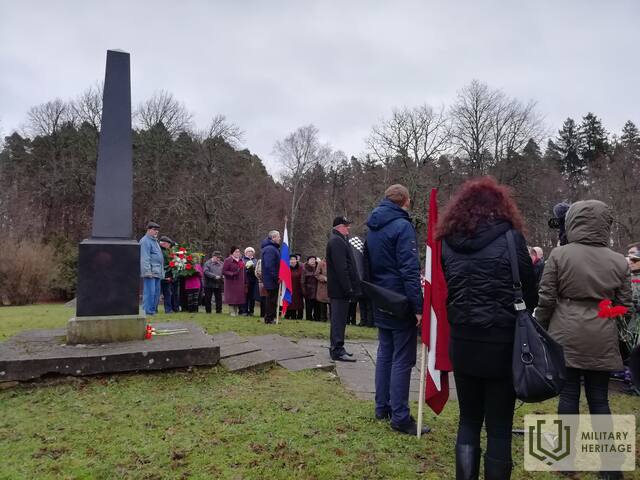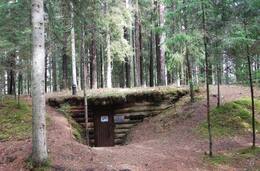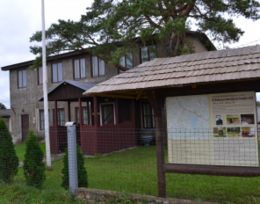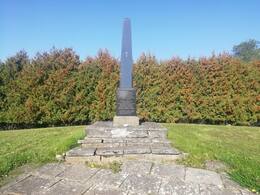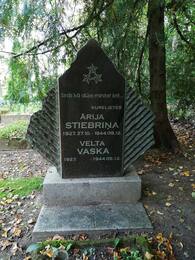Zlēkų tragedijos vieta Latvijos istorijoje vis dar neaiški.
Antrojo pasaulinio karo metu, kai didžiąją Latvijos dalį jau kontroliavo Sovietų Sąjunga, o Kuržemę valdė Hitlerio vokiečių vietininkai, vadinamieji kureliečiai Kuržemėje pradėjo kovą už Latvijos valstybinės nepriklausomybės atkūrimą.
Kureliečių leitenanto Roberto Rubenio bataliono desperatiškas ir idealistinis karinis pasipriešinimas vokiečių 16-osios armijos, SD ir SS dalinių dalims truko nuo 1944 m. lapkričio 14 d. iki gruodžio 9 d. Ugalės, Usmos, Rendos ir Zlėkų valsčiuose ir baigėsi tragiškais įvykiais 1944 m. gruodžio 9 ir 10 d. Zlėkų valsčiuje, Ventspilio rajone.
Per šias dvi dienas, kovodami su nacionaliniais ir sovietiniais partizanais, vokiečiai nusprendė nubausti juos palaikiusius vietos gyventojus – žemėlapyje nubrėžė Zlėką apskritimu ir jį apsupo. Visi ten buvę asmenys buvo nužudyti, o visi aštuoni namai pažymėtoje teritorijoje buvo sudeginti. Dauguma nužudytųjų buvo pabėgėliai iš visiškai skirtingų Latvijos vietų, daugelis jų atvyko visai neseniai.
Ar dar nepakankamai supratome ir įvertinome Zlėkų tragedijos reikšmę Latvijos istorijoje, taip pat aptariama pokalbyje su fiziku Olgertu Lielausu, Latvijos mokslų akademijos nariu. Jis vadovavo prieš dešimt metų įkurtai Latvijos mokslų akademijos iniciatyvinei grupei, kurios užduotis buvo išsaugoti istorijai ir nacionalinei atminčiai ryškiausius Latvijos pasipriešinimo judėjimo Antrojo pasaulinio karo metu ir jo aukų įrodymus.
1944 m. gruodį Lielausui buvo 14 metų ir trys mėnesiai, ir jis vis dar gali papasakoti apie tai, kas tuo metu įvyko, taip pat prisimena keletą ryškių epizodų.
„[Rubenio bataliono] pėstininkai ėjo Abava, bet vežimai važiavo per Cirkalę. Ten buvo kelias. Pamenu, Cirkalė buvo pilna pabėgėlių. Kareiviai įėjo į didelį pastatą, kurio nebėra. Jie domėjosi, kokius ginklus turi vokiečiai. Ar jie turi pėstininkų ar kitų ginklų? Žmonės kalbėjo, kad sužeistas leitenantas Rubenis buvo vežamas vežimu.“
Netoli Cirkalės yra namai, kuriuos [vokiečiai sudegino 1944 m. gruodžio 7–10 d.] – „Grauči“, šalia „Graučių“ yra „Jaunarāji“, kur gyveno mano giminaičiai, kurie visi buvo sušaudyti. Iš viso buvo sudeginti aštuoni namai. Aukščiausias vokiečių SS ir policijos pareigūnas Ostlande Jekelnas žemėlapyje esą nupiešė dar didesnį apskritimą, įskaitant Cirkalę, kur turėjo būti įvykdyta bausmė, tačiau tam buvo protestuota.
„Didžiausia neteisybė yra ta, kad čia buvo sušaudyta apie 160 žmonių. Dažniausiai visi kalba apie kareivių didvyriškumą, bet kaip jie gali tai susieti su tragedija? Net Mokslų akademija įsteigė specialią komisiją, kad išsaugotų Zlēkų tragedijos įrodymus istorijai, tačiau ši byla merdi ir iki šiol nepavyko jos rimtai pajudinti į priekį.“
Karo meto keistenybės ir įdomybės
Paklaustas, ar tai nebuvo didžiausias mūšis, kuriame latviai labai rimtai susidūrė su vokiečiais, Lielauss atkreipia dėmesį, kad kai kur nebuvo nė vieno vokiečio. „Netoli Abrinios, kitoje Abavos pusėje, jie keikė rusiškai, nes ten buvo vlasoviečiai, bet šioje pusėje buvo latgaliai. Tuo metu buvo madinga, kad drąsiausi vyrai šaudytų iš rusiško sunkiojo kulkosvaidžio „Maxim“ iš peties. O vienas iš jų, latgalis, šaudydamas keikė rusiškai, ir iš kito kranto girdėjosi rusiški keiksmai.“
„Mano krikštamotė gyveno Cirkalėje su savo vyru, miškininku. Vasarą apsistodavau pas juos. Cirkalėje buvo dislokuotas vokiečių „Jagdverband“ dalinys, kuris buvo pavaldus SD. Jame buvo apie 40–50 žmonių, bet tarp jų praktiškai nebuvo vokiečių, bet buvo vengrų, totorių, latvių. Jiems vadovavo vokiečiai. Šis dalinys rūpinosi „Raudonąja strėle“ [sovietų partizanais]. Pamenu epizodą, kai viename iš tvartų į didelį katilą varė kandžius, nes kareiviai prieš eidami į mišką pasigerdavo, ir taip buvo abiejose pusėse.“
Dar vienas epizodas – Cirkalėje, kur buvo vokiečių dalinys, du latvių kareiviai buvo sugauti ir uždaryti dideliame tvarte. Juos taip pat saugojo latviai. Pamenu, kaip vienas iš jų sakė: „Jansonai, eik ir pasakyk fritams, kad vienas iš jų susprogdino“. Sargybiniai nustatė, kad langų grotos buvo perkeltos ir vienas iš sulaikytųjų, vagis, pabėgo, bet kitas sulaikytasis turėjo atostogų pažymėjimą, kuris buvo laikomas saugiu dokumentu, ir nors jis galėjo pabėgti, to nepadarė.
Atvyko sargybos viršininkas, austras unteršarfiureris, gražus ir dukterų labai mėgstamas vyras. Jis išėjo ir, kilus sumaiščiai, civilių pabėgėlių akivaizdoje, nušovė sulaikytąjį su atostogų pažymėjimu, kuris nebuvo pabėgęs. Sumaištis buvo dar didesnė, šaulys sutriko, nes nelaimė įvyko jo sargybos pamainos metu, visi esantys sutriko. Vokiečiai nedelsdami išsivežė nušautąjį...
Dar vienas epizodas „Cirkalėje“ – mano tėvas buvo įjungęs radiją, kad galėtų klausytis anglų žinių. Kartą jis klausėsi kambaryje, ir iš paskos įėjo vokiečių vadas. Mano tėvas manė, kad bus didelė netvarka, bet ne, vokietis jį paguodė ir paklausė, kur dabar Vakaruose yra frontas. Jis turėjo šeimos kažkur Vokietijoje ir domėjosi, ar ten įžengė anglai, prancūzai ar amerikiečiai.
Padėtis buvo tokia, kad net vokiečiai nežinojo, kas vyksta jų namuose. Tuo metu taip buvo ir Cirkalėje.
Zlēkų tragedijos memorialas
„Rusijos laikais buvo priimta: kiekviena respublika turėjo turėti daugiaaukštį pastatą, mes turime Mokslų akademiją, ir buvo priimta: kiekvienai respublikai, kaip taisyklė, reikia vokiečių avarinių darbų. Baltarusijoje, Ukrainoje jų galima turėti kiek nori, bet mes jų neturėjome, tik Audriniuose.“
Iki šiol Mokslų akademijoje manėme, kad didžiausias karo nusikaltimas Latvijoje buvo įvykdytas Zlėkoje, kuris iki šiol yra pamirštas. Zlėkos tragediją sovietmečiu tyrė akademikas Vilis Samsonas, pats kovojęs sovietų partizanų junginyje.
Paskutiniajame karo etape daugelis Zlėkų valsčiaus gyventojų teikė pagalbą sovietų partizanams ir žvalgybos pareigūnams, rėmė dezertyrus iš vokiečių fašistinės armijos. Įsiutęs dėl nesėkmės kovoje su partizanais, generolo Friedricho Jekelno vadovaujama baudžiamoji ekspedicija žiauriai atkeršijo vietos gyventojams.
Tačiau sovietų partizanai Jekelnos nebuvo supykdę – „Raudonoji strėlė“ sėdėjo krūmuose netoli Zlėkos ir stebėjo, kas vyksta. Jekelną supykdė kureliečių kova ir rubenių karinis pasipriešinimas, o apie 160 nekaltų žmonių – didelių ir mažų, vietinių gyventojų ir pabėgėlių, kurie gerą savaitę praleido karinėje teritorijoje, – už tai sumokėjo savo gyvybėmis.
Šiandien Zlėkoje yra Kartuvių kalnas. Jame perlaidoti kai kurie nužudytieji. Apie dvidešimt riedulių su nužudytųjų vardais sudaro ratą, o centre – maždaug trijų metrų aukščio juodo marmuro obeliskas. Manoma, kad jis paimtas iš senųjų „žydų kapinių“ Rygos Maskavas forštadėje.
„Ar nebūtų laikas jį grąžinti ir vietoj jo įrengti latvišką riedulį su šiandienos užrašu ir kryžiaus ženklu? Manau, kad Zlėkos tragedijos aukoms turėtų būti parodyta derama pagarba, o vieta šiai pagarbai pareikšti simboliškai būtų Kartuvių kalnas Zlėkoje. Kureliečių kovoje už Latvijos nepriklausomybės atkūrimą buvo sunaikinta 160 žmonių, ir šie kovotojai nebuvo naudingi nei vokiečių, nei sovietų okupacinei valdžiai.“
Delfi (2014.11.12.) Praėjo 70 metų nuo Zlēkų tragedijos; jos vieta Latvijos istorijoje vis dar neaiški . Prieinama: https://bit.ly/3sj6Sdp
Susijusi laiko juosta
Susijusios vietos
Rubenio bataliono bunkeris ir mūšio laukai
Restauruotas Rubenio bataliono 2-osios kuopos žeminė yra miške prie Ilziki ežero Usmos valsčiuje. Žeminę galima apžiūrėti iš išorės nemokamai bet kuriuo metu. Tačiau ekskursijas žeminės viduje būtina užsisakyti iš anksto.
Leitenanto Roberto Rubenio batalionas buvo generolo Jānio Kurelio suformuoto karinio dalinio dalis ir žinomas dėl to, kad nepasidavė vokiečių kariuomenei ir demonstravo didelį pasipriešinimą. 1944 m. lapkričio 14–gruodžio 9 d. Ugalės, Usmos, Rendos ir Zlėkų valsčiuose vyko įnirtingi mūšiai tarp 16-osios Vokietijos armijos, SD ir SS dalinių, vadovaujamų policijos generolo Friedricho Jeckelio, ir Kureliečių dalinio bataliono, vadovaujamo leitenanto Roberto Rubenio. Rubenio vadovaujami vyrai buvo gerai ginkluoti ir organizuoti, nesiejo savęs su jokia iš dviejų priešiškų okupacinių jėgų. Jų veiksmai laikomi plačiausiais ir ilgiausiais Latvijos nacionalinio pasipriešinimo judėjimo istorijoje. Mūšiuose prie Rendos ir Zlėkų žuvo apie 250 vokiečių kareivių, o Rubenio vyrai patyrė tik 50 aukų. Tų dienų įvykius simbolizuoja miške atkurta žeminė (velėna dengta, žemėje iškasta rąstinė trobelė), kurioje kadaise buvo apsistoję Rubenio bataliono vyrai.
Rubenio bataliono muziejus
Rubenio bataliono muziejus yra Ugalėje. Jis skirtas R. Rubenio batalionui, kuris 1944 m. tarnavo ir kovojo Kuržemėje vadovaujant generolui J. Kureliui, kurelių veiklai ir nacionaliniam pasipriešinimo judėjimui. Muziejuje yra ekspozicija apie Latvijos Centrinės Tarybos (LKT) ir jos Ventspilio grupės veiklą, taip pat LKT memorandumas su 188 parašais ir signatarų nuotraukomis, įtrauktas į UNESCO programos „Pasaulio atmintis“ Latvijos nacionalinį registrą. LKT buvo bendras Latvijos aukščiausios politinės vadovybės ir pogrindinės vyriausybės, veikusios Latvijos okupacijos metu nuo 1943 iki 1994 m., centras. Jis buvo įkurtas siekiant koordinuoti įvairių Latvijos pasipriešinimo judėjimų veiklą, siekiant atkurti Latvijos nacionalinę nepriklausomybę. Muziejus taip pat siūlo kelionę į bataliono istorijai reikšmingas vietas (gyvenvietę su rekonstruotu bunkeriu Usmos valsčiuje, mūšio laukus Rendos ir Zlėkų valsčiuose ir kt.).
Zlēku tragedijos memorialinė vieta
Memorialas yra netoli Zlėkų dvaro ansamblio, vakarinėje Karātavkalno dalyje. Ratą sudaro apie dvidešimt riedulių su žuvusiųjų vardais, o centre – maždaug trijų metrų aukščio juodo marmuro obeliskas.
Kai kurie žuvusieji buvo perlaidoti Zlēkų memoriale.
1944 m. gruodį Zlēkų apylinkėse nacistinė vokiečių armija įvykdė didelio masto operaciją prieš civilius gyventojus. Armijų grupės „Nord“ kovinių veiksmų žurnale 1944 m. gruodžio 9 d. 17.30 val. buvo įrašyta, kad per mūšį priešo pusėje žuvo 161 žmogus, priklausęs „Rubenso brigadai ir Raudonosios strėlės daliniams“. Sovietmečiu šis skaičius, matyt, buvo laikomas bendru Zlēkų tragedijos aukų skaičiumi, kalbant apie žuvusius civilius gyventojus.
Veiksmų eiga iš dalies dokumentuota 1944 m. gruodžio 31 d. Vokietijos 16-osios armijos kontržvalgybos skyriaus vadovo ataskaitoje. Joje aiškinama, kad gruodžio 5–9 dienomis, vadovaujant aukščiausiam SS ir policijos vadovui Ostlande, SS oberruppenfiureriui ir policijos generolui Friedrichui Jekelnui, Eichensumpfe („Ąžuolų pelkėje“) vyko didelio masto operacija prieš „Raudonąsias strėles“ ir generolo Kurelio grupės likučius Abavoje.
Paminklas Rubenio bataliono medikams
Paminklas Cirkalės kapinėse kunigams Ārijai Stiebriņai ir Veltai Vaskai, kuriuos vokiečiai sušaudė 1944 m. lapkričio 9 d. Sukūrė skulptorius J. Karlovas.
Abi moteris 1944 m. gruodžio 9 d. sušaudė Vokietijos nacių armijos daliniai kartu su kitais nelaisvėje paimtais Zlėkų apylinkių gyventojais, dezertyrais iš Vokietijos armijos ar panašiais asmenimis.
Pasak pasakojimų, jaunos moterys savanoriškai įstojo į Rubenio batalioną. Jos keliavo kartu su Rubenio batalionu iš Suntaži į Usmą. Tačiau Jekelno operacijos „Eichensumpf“ metu jaunos moterys buvo suimtos kelyje, nuvežtos į Vēlogų girininko namus tardymui ir sušaudytos kartu su nedidele grupe kitų sulaikytųjų. Cirkalės gyventoja moteris pažinojo Āriją ir sugebėjo perlaidoti abiejų mergaičių palaikus Cirkalės kapinių pakraštyje bei prižiūrėjo šias kapines per visą sovietų okupaciją.
Vadovaujant vyriausiajam SS ir policijos vadui Ostlande, SS obergruppenfiureriui ir policijos generolui Friedrichui Jecklenui, gruodžio 5–9 dienomis vyko didelio masto operacija „Eichensumpf“ („Ąžuolų pelkė“), nukreipta prieš „Raudonosios strėlės“ kovotojus ir generolo Kurelio grupę netoli Abavos.
Kampanijos eiga iš dalies dokumentuota 1944 m. gruodžio 31 d. ataskaitoje.




